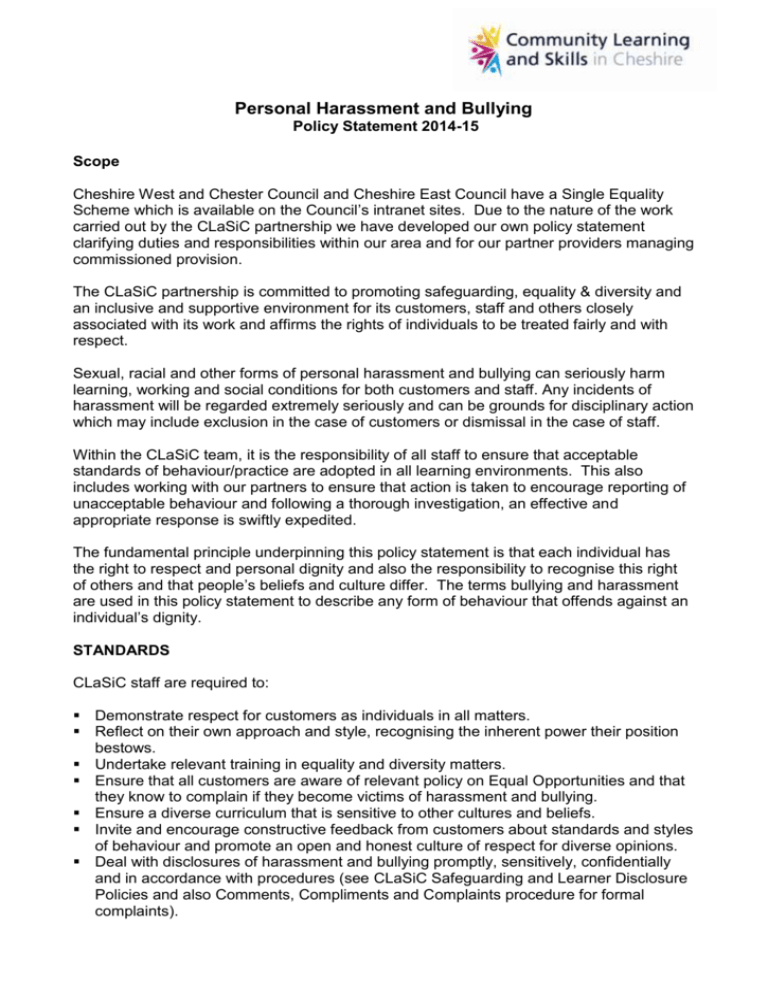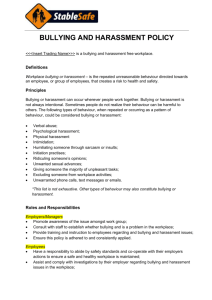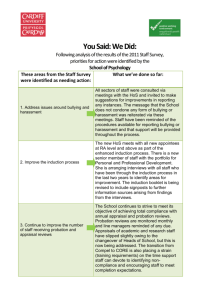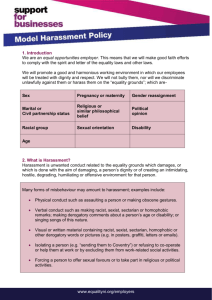Bullying and Harassment 14-15
advertisement

Personal Harassment and Bullying Policy Statement 2014-15 Scope Cheshire West and Chester Council and Cheshire East Council have a Single Equality Scheme which is available on the Council’s intranet sites. Due to the nature of the work carried out by the CLaSiC partnership we have developed our own policy statement clarifying duties and responsibilities within our area and for our partner providers managing commissioned provision. The CLaSiC partnership is committed to promoting safeguarding, equality & diversity and an inclusive and supportive environment for its customers, staff and others closely associated with its work and affirms the rights of individuals to be treated fairly and with respect. Sexual, racial and other forms of personal harassment and bullying can seriously harm learning, working and social conditions for both customers and staff. Any incidents of harassment will be regarded extremely seriously and can be grounds for disciplinary action which may include exclusion in the case of customers or dismissal in the case of staff. Within the CLaSiC team, it is the responsibility of all staff to ensure that acceptable standards of behaviour/practice are adopted in all learning environments. This also includes working with our partners to ensure that action is taken to encourage reporting of unacceptable behaviour and following a thorough investigation, an effective and appropriate response is swiftly expedited. The fundamental principle underpinning this policy statement is that each individual has the right to respect and personal dignity and also the responsibility to recognise this right of others and that people’s beliefs and culture differ. The terms bullying and harassment are used in this policy statement to describe any form of behaviour that offends against an individual’s dignity. STANDARDS CLaSiC staff are required to: Demonstrate respect for customers as individuals in all matters. Reflect on their own approach and style, recognising the inherent power their position bestows. Undertake relevant training in equality and diversity matters. Ensure that all customers are aware of relevant policy on Equal Opportunities and that they know to complain if they become victims of harassment and bullying. Ensure a diverse curriculum that is sensitive to other cultures and beliefs. Invite and encourage constructive feedback from customers about standards and styles of behaviour and promote an open and honest culture of respect for diverse opinions. Deal with disclosures of harassment and bullying promptly, sensitively, confidentially and in accordance with procedures (see CLaSiC Safeguarding and Learner Disclosure Policies and also Comments, Compliments and Complaints procedure for formal complaints). Customers are required to: Behave towards each other and their staff member with respect at all times. Help prevent harassment and bullying by challenging and reporting behaviour that appears to be causing distress to others. Support an open, constructive learning environment within which a range of opinions and beliefs are acknowledged and respected. Talk to us about anything they feel uncomfortable about (see CLaSiC Learner Disclosure Policy) ACTION TO BE TAKEN We have a duty to protect our customers and it is important any information disclosed to you by customers is given the highest priority and the correct procedures are followed. See our CLaSiC Safeguarding policy. The majority of cases will respond to an informal approach with appropriate support and guidance offered but if the information came from a customer, record the incident on a Disclosure form and return to the Reporting Officer named on the form. Whatever the source of the information and level of seriousness, ensure the Reporting Officer at your organisation is notified so appropriate action can be taken. In serious cases, it may involve a formal investigation through the official Council Safeguarding procedures. If a formal complaint is made, the course of action is laid out in the CLaSiC Complaints policy. WHAT IS HARASSMENT? Any behaviour which shows lack of respect and which creates an atmosphere in which people feel uncomfortable and unwelcome can constitute harassment. Differences of attitude and culture or misinterpretation of social signals can mean that what is perceived as harassment by one person may not so to another. SEXUAL HARASSMENT – could include: Any behaviour which patronises, intimidates or offends, eg remarks, looks, jokes or offensive language Any behaviour which makes people feel viewed as sexual objects and which causes offence, even if unintended Provocative suggestions, propositioning people The display of pornographic, semi-pornographic or suggestive material, electronic or paper Deliberate, potentially objectionable physical contact to which the person has not consented or had the opportunity to object to Threats of academic failure, or promises of success or other rewards in exchange for sexual favours This applies equally well to harassment occurring between people of opposite gender, either of women by men or men by women or between people of the same gender. RACIAL HARASSMENT – could include Any behaviour which causes discomfort, intimidates or offends or which incites others to do so – derogatory names, insults, racist jokes or ridiculing cultural difference The display or circulation of offensive material, including racist graffiti, electronic mail or information published through the Internet Verbal abuse and threats of physical attack PERSONAL HARASSMENT – could include Behaviour which makes direct or indirect reference to disability or impairment – and thus causes discomfort, patronises, insults or offends people with a physical, sensory or mental disability Behaviour which makes direct or indirect reference to religion or culture thereby causing discomfort or offence Repeated gibes in reference to personal traits, appearance or sexual orientation Invasion of privacy or practical jokes causing physical or psychological distress Pressure to become involved in anti-social or criminal behaviour Messages to, or about a person, including electronic mail and social media, that are offensive, insulting or cause discomfort BULLYING – could include Bullying is the misuse of power or position to persistently criticise and condemn; to openly humiliate and undermine an individual’s ability until this person becomes so fearful that their confidence crumbles and they lose belief in themselves. These attacks on the individual are normally sudden, irrational, unpredictable and usually unfair. ‘Academic bullying’ has been defined as: ‘asserting a position of intellectual superiority in an aggressive, abusive or offensive manner, threats of academic failure or public sarcasm’. Bullying could include: Verbal and/or physical intimidation – threats, shouting, derisory remarks, often in front of others Excessive supervision Undermining an individual’s position by changing learning or work objectives/guidelines without consultation, taking credit for the target’s work, deriding the target’s work to tutors or managers, etc Removing areas of responsibility and giving people menial or trivial tasks to do instead Withholding information Spreading malicious rumours Persistent criticism Messages, including electronic mail and social media, that are threatening, derisory or defamatory

![Bullying and Harassment Advisor role des[...]](http://s3.studylib.net/store/data/006976953_1-320eb77689e1209d082c9ec2464350ee-300x300.png)






